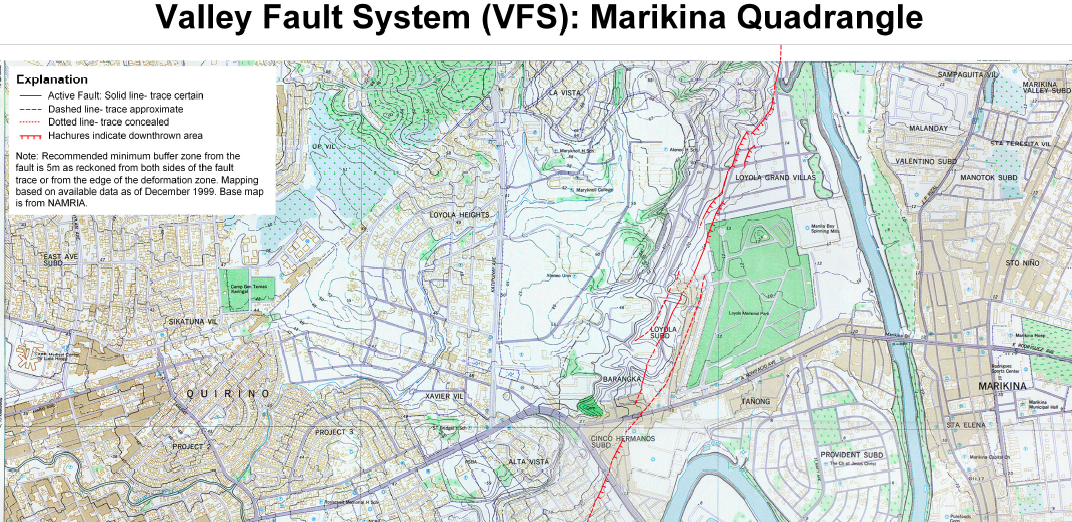IN AN effort to address a misconception about part of the campus sitting on the West Valley Fault, the Ateneo released a statement on October 18 clarifying that no Ateneo building is located on the fault line.
The statement displayed a high-resolution image of the fault, which spans from the Loyola Grand Villas to Green Meadows.
The misconception stemmed from an ABS-CBN News article entitled “Ateneo buildings on top of West Valley Fault.”
According to the article, Philippine Institute of Volcanology and Seismology (Phivolcs) geologists said that at least three buildings inside the Ateneo campus are sitting on top of the active fault.
Vice President (VP) of Social Development Atty. Jaime Hofileña said that the buildings in question are the Sonolux building, the Loyola House of Studies and the Center for Family Ministries. The structures are owned by the Philippine Province of the Society of Jesus. Ateneo students do not occupy these buildings.
The Ateneo statement also cited the 2013 presentation of Phivolcs Director Renato Solidum, Jr.
Solidum’s presentation included the results of a Philippine-Australian government study called the “Greater Metro Manila Area Risk Analysis Project.” It concluded that, should a 7.2 magnitude earthquake in the West Valley Fault occur, this would lead to severe damage in Metro Manila.
Taking that into consideration, the Ateneo said that it has been preparing for potential disasters by adding new procedures to the currently existing disaster and risk management plans, which include earthquake drills.
According to the statement, more specialized guidelines and drills for different sectors and age levels are being prepared.
Facilities Management Office (FMO) Officer-in-Charge (OIC) Ronald Santos said that the FMO is prepared to participate in “risk reduction and emergency response seminars and workshops.”
Santos added that there are plans to make these available to other concerned offices to raise awareness on disaster preparedness.
“The FMO Safety and Security unit also conducts government-mandated occupational safety and health seminars to strengthen such initiatives,” he said.
On structural integrity
In a separate interview with The GUIDON, University President Jose Ramon Villarin, SJ assured that all university buildings are currently being examined.
Although buildings constructed from 2001 onwards were built to withstand more severe conditions, all buildings will be inspected to ensure and confirm structural integrity and so that necessary reinforcements may be performed.
FMO OIC Santos shared that collaboration among the different campus units as well as consultation with structural engineers have already been done.
“[These were done] in order to technically evaluate the soundness of our buildings,” he said.
According to Santos, the Ateneo is taking “proactive measures” such as building inspections and a review of as-built plans toward ascertaining that the university buildings comply with current building codes.
However, as to the assurance of any prevention of danger, Hofileña said, “Specific circumstances of any earthquake cannot be predicted, so the absolute prevention of any adverse effects simply cannot be guaranteed.”
Ateneo Institute of Sustainability
Villarin said that a program under the Ateneo Institute of Sustainability (AIS) was created to conduct researches on disaster risk reduction.
The program was entitled the “Climate Change and Disaster Risk.” This is currently under Gemma Narisma, PhD.
“Hopefully, this kind of research will someday be translated into executable programs and measures and policies not just for the Ateneo, but for the country,” Villarin said.
He also said that a committee of the AIS is currently reviewing and consolidating the documents to ensure that university guidelines are consistent with a Disaster Mitigation Literacy Program that the university will be implementing.
Villarin did not disclose when the program would be implemented.
Cavalier culture
VP for Social Development Hofileña said that to attain the maximum level of safety in any disaster situation means to remind individual members of the Loyola Schools community about the concepts of safety and risk.
According to Villarin, risk seemed “foreign” to the Philippine culture. He made reference to the “cavalier” attitude usually practiced with seatbelts and pedestrian lanes.
“We need to educate others and ourselves on this complex reality called ‘risk’ and plan our cities, houses, and lives accordingly,” he said.
Likewise, Santos believes that a new culture with regard to safety and risk should be inculcated among the members of the Ateneo community.
“We need to instill a culture of readiness in each individual to truly achieve the essence of being alert and prepared for any disaster that we may encounter,” he said.
Sanggunian President Dan Remo expressed his plans to further engage the Ateneo student body through focusing on disaster preparedness and response.
“The effects of the two typhoons and the earthquakes would be the priority first,” Remo said, referring to Typhoon Labuyo, Typhoon Maring and the Bohol earthquake.
“There has to be a more proactive policy towards disaster response,” Remo said.
He added that the Sanggunian is still in the planning stages of such a policy.







